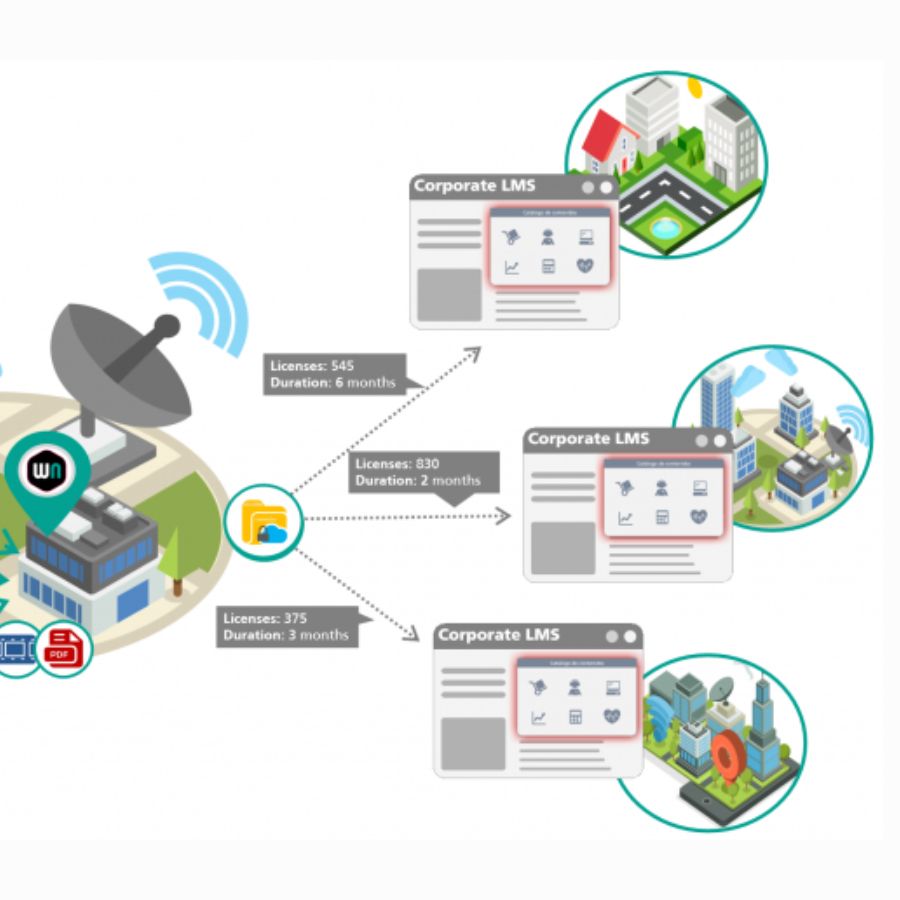Maximize the effectiveness of your online training with WelcomeNext
Due to constant technological advancements and the introduction of new concepts, online training has evolved to become a crucial pillar in the growth and professional development of businesses. In response to the growing demand for quality educational solutions, WelcomeNext emerges as a prominent leader in the field of online training. This platform offers a wide range of services and products designed with the clear purpose of maximizing training effectiveness and boosting the professional development of corporate teams. Do you want to learn more? Don’t miss out on all the features of WelcomeNext! E-Learning Content Catalog: A Strategic Selection for Professional Development WelcomeNext stands out for its strategic approach in building its e-learning content catalog. The selection is based on three key criteria: Most consumed courses in major knowledge areas. Courses in demand with no offerings in the sector. Courses on innovative topics. This strategy ensures that companies have access to relevant and up-to-date content, providing students with a enriching learning experience for their professional development. Cybersecurity and Cyber Defense Training One of the highlights of WelcomeNext is our offering of cybersecurity and cyber defense training. In an increasingly complex digital environment, equipping your team to handle threats such as social engineering, phishing, and ransomware is crucial. Training not only reduces the risk of cyberattacks but also prepares your company to obtain certifications such as ISO 27001, demonstrating a commitment to data security and the professional development of your employees. Competency-based learning for better professional development WelcomeNext’s competency-based learning methodology makes a difference by facilitating the assessment of training impact and return on investment in professional development. With a catalog of content designed specifically under this approach, companies can customize training paths for key areas such as Digital Marketing, Sales, Finance, among others, driving the professional development of their teams. Advanced technology for an optimal learning experience Technology is a fundamental pillar in WelcomeNext’s value proposition. Our content utilizes state-of-the-art HTML5 technology, ensuring compatibility with the latest browsers. The inclusion of the SCORM 1.2/SCORM 2004 standard facilitates integration with any LMS platform in the market, providing flexibility to companies and supporting continuous professional development. Cloud technology allows for secure and efficient content hosting, with SCORM connectors for seamless remote distribution. Gamification elements, Level tests and Interactive Feedback At WelcomeNext, we also incorporate functional features that enhance the learning experience and professional development: Gamification Elements: Motivate students by including game elements, encouraging more active and participative learning. Level Tests and Interactive Feedback: Evaluate progress with tests for each Minimum Learning Unit and provide interactive feedback for continuous improvement in professional development. Educational Videos and Simulators: Use visual resources for a deeper understanding of concepts, enriching the learning experience and professional development. Progress and Achievement Map: Visualize progress and achievements for effective tracking in the professional development of each individual. WelcomeNext E-Learning products and services WelcomeNext offers four effective solutions to empower companies to transform online training efficiently and effectively. Let’s delve into the details of each. WelcomeLMS: An e-Learning Platform (LMS) for Online Training WelcomeNext offers WelcomeLMS, an advanced Virtual Campus serving as an e-Learning Platform (LMS) for both internal employee training and commercial initiatives. This cloud-based solution provides the flexibility to host e-Learning courses, allowing companies to use it for both internal training and course sales. scormNEXT: SCORM Cloud Platform for Remote Content Distribution The scormNEXT platform centralizes and maintains content securely in the cloud. It provides users with total control over content access and the ability to track student participation. This solution is essential for companies seeking seamless remote distribution and precise control over the use of their training materials. SCORM Debugger: SCORM Debugger for Content Developers To ensure the quality and compatibility of e-Learning courses, WelcomeNext provides SCORM Debugger, an essential tool for content developers. This suite of tools allows for quick and easy testing, debugging, and validation of courses, ensuring they comply with SCORM standards and run smoothly on any LMS platform. scormPLAYER: Integrable SCORM Engine for Management and Playback of SCORM, MP4, MP3, and PDF Content scormPLAYER is an integrable SCORM engine that enhances the management and playback of e-Learning content. Additionally, it is compatible with formats such as SCORM, MP4, MP3, and PDF. scormPLAYER integrates directly into web applications like CMS, LMS, intranets, and websites, turning them into advanced learning platforms. Contracting Model: Flexibility and Economic Efficiency WelcomeNext’s contracting model is as flexible as its solutions. By offering content under license in the corporate LMS or WelcomeNext’s Virtual Campus, companies pay only for licenses consumed on the first access of each student. This consumption-based payment approach, with no entry fee, is complemented by special discounts based on the volume of licenses contracted, ensuring economic efficiency and supporting continuous professional development. Conclusion In summary, WelcomeNext is a comprehensive ally for companies looking to maximize the effectiveness of their training and foster the professional development of their teams. From a strategically selected catalog to advanced technical and functional features, WelcomeNext offers solutions that adapt to the changing needs of today’s business world. By choosing WelcomeNext, you are investing in the continuous professional development of your team and ensuring a path to success in a competitive and ever-evolving environment. To discover more about the solutions offered by WelcomeNext, we invite you to explore our website.




